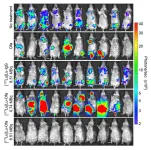(Press-News.org) ITHACA, N.Y. – The demand for battery-grade lithium, nickel, cobalt, manganese and platinum will climb steeply as vehicle electrification speeds up and nations work to reduce greenhouse gas emissions through mid-century. This surge in demand will also create a variety of economic and supply-chain problems, according to new Cornell University research published in Nature Communications.
In the new paper, senior author Fengqi You, professor in energy systems engineering, and his colleagues examined 48 countries that are committed to playing a strong role in electrifying transportation, including the U.S., China and India.
Under a scenario where 40% of vehicles are electric by 2050, the need for lithium globally will increase 2,909% from the 2020 level. If 100% of vehicles are electric by 2050, the need for lithium more than doubles, to 7,513%.
From the years 2010 to 2050, in a scenario where all vehicles are electric, the annual demand for lithium would increase globally from 747 metric tons to 2.2 million metric tons.
By mid-century, for example, the demand for nickel eclipses other critical metals, as the global need ranges from 2 million metric tons, where 40% of vehicles are electric, to 5.2 million metric tons where all vehicles are electric.
The annual demand for cobalt (ranging from 0.3 to 0.8 million metric tons) and manganese (ranging from 0.2 to 0.5 million metric tons) will rise by the same order of magnitude in 2050, according to the paper.
Currently, critical metals and minerals are centralized in politically unstable Chile, Congo, Indonesia, Brazil, Argentina and South Africa, according to the World Bank.
“The unstable supplies of critical metals and minerals can exacerbate supply risks under surging demand,” You said.
In the paper, the researchers urge caution on the electrification of heavy-duty vehicles, which require more critical metals than other vehicles. Although they account for only between 4% and 11% of the total road fleet in some countries, battery-related critical metals used in heavy-duty electric vehicles will account for 62% of the critical metal demand in the decades ahead.
Among the researchers’ suggestions for managing this demand:
Constructing a circular economy would be indispensable to the critical metals if it achieved a closed-loop supply chain in the future. Strategies should be considered to promote the recycling efficiency and recovery rate of end-of-life batteries at a proper pace.
Countries should adopt policies that prioritize alternative designs for cathodes/anodes and fuel-cell (green hydrogen) systems to reduce the reliance on primary critical metals.
Decarbonization targets for road transportation should be coupled with electric vehicle deployment, the timing of carbon peak and neutrality, and accurate emission budgets.
The research was supported by the National Science Foundation.
For additional information, see this Cornell Chronicle story.
-30-
END
Electrification push will have enormous impacts on critical metals supply chain
2023-04-11
ELSE PRESS RELEASES FROM THIS DATE:
Takeda licenses small molecule developed by Krembil Brain Institute researchers, targeting tau protein implicated in Alzheimer’s disease
2023-04-11
As announced today in a press release by biotechnology company Treventis, global pharmaceutical company Takeda has agreed to exclusively license a group of small molecules that target tau – a protein in which misfolding and aggregation are believed to be a cause of Alzheimer’s disease.
The molecules were developed by the team at Treventis, building upon the Alzheimer’s & neurodegenerative research expertise of Dr. Donald Weaver’s lab at UHN.
“There are currently no effective drugs out there that target tau in the brain,” says Dr. Donald Weaver, Senior ...
Mount Sinai researchers discover novel receptors for SARS-CoV-2 and their age-dependent expression, providing new insights for public health
2023-04-11
New York, NY (April 11, 2023) – A study led by Mount Sinai researchers Dr. Bin Zhang, the Willard T.C. Johnson Research Professor of Neurogenetics, and Dr. Christian Forst, an Associate Professor in the Department of Genetics and Genomic Sciences, have identified potential novel receptors for SARS-CoV-2 and unveiled their tissue-specific and age-dependent expression. The findings were published on March 23 in the Federation of European Biochemical Societies Letters.
The study's multiscale network analysis suggests that SARS-CoV-2 utilizes multiple novel receptors, such as the TYOBP receptor CD300e, to facilitate ...
Perfume component helps lure male moth pests
2023-04-11
North Carolina State University researchers have shown that adding a small amount of a chemical used in perfumes – nonanal – to a two-chemical combination of other sex pheromones helped increase the cocktail’s effectiveness in mimicking female fall armyworm “come hither” calls to males.
The findings could eventually help farmers better detect, monitor and control fall armyworm populations, which negatively affect some 350 plant species – including crops like corn and cotton as well as turfgrass and other cultivated grasses.
“Nonanal is emitted ...
Genomic surveillance identifies global strain of emerging wheat disease fungus
2023-04-11
Pests and diseases may reduce global wheat yields by over 20%. A study published April 11th in the open access journal PLOS Biology by Sergio Latorre at University College London, UK and colleagues suggest that genomic surveillance may be an effective disease management tool with the ability to trace lineages of emerging crop diseases, and to identify genetic traits for breeding disease-resistant lines.
Wheat crops across the globe are threatened by wheat blast, an emerging fungal disease. However, disease-management strategies have been unsuccessful. In order to better understand ...
$9.5M to fund cross-disciplinary chronic fatigue research
2023-04-11
ITHACA, N.Y. -- A Cornell multidisciplinary research center that studies chronic fatigue syndrome has received a five-year, $9.5 million grant from the National Institutes of Health’s National Institute of Allergy and Infectious Disease – funding that will enable experts from disparate fields to work together on the mysterious and debilitating condition.
The Cornell Center for Enervating Neuroimmune Disease, established in 2017, ultimately seeks to understand the biological ...
Study offers insights into how COVID variants escape immune system ‘killers’
2023-04-11
New Haven, Conn. — Omicron subvariants of SARS-CoV-2 — the virus behind COVID-19 — have shown an uncanny knack for evading antibodies produced either by vaccines or exposure to earlier versions of the virus, leading to many breakthrough infections. However, in order to sicken people, these viral variants must also avoid “killer” T cells, immune cells that are unleashed when the immune system detects foreign pathogens.
A new Yale study published April 10 in the Proceedings of the National Academy of Sciences reveals new insights into how these Omicron variants are able to avoid destruction by these T cells.
For the study, ...
Untangling the mystery of sleep
2023-04-11
At a glance
Dragana Rogulja is using fruit flies and mice to explore tantalizing questions about sleep.
Her research delves into why sleep is necessary for survival, and how the sleeping brain disconnects from the world.
Rogulja’s research has identified a critical connection between the brain and the gut.
If translated into humans, the results of her work could lead to new ways for improving sleep and reducing damage from sleep deprivation.
Sleep is one of the most essential human activities — so essential, in fact, that if we don’t get enough sleep for even one ...
New nuclear medicine therapy cures human non-hodgkin lymphoma in preclinical model
2023-04-11
Reston, VA—A new nuclear medicine therapy can cure human non-Hodgkin lymphoma in an animal model, according to research published in the April issue of The Journal of Nuclear Medicine. A single dose of the radioimmunotherapy, [177Lu]Lu-ofatumumab, was found to quickly eliminate tumor cells and extend the life of mice injected with cancerous cells for more than 221 days (the trial endpoint), compared to fewer than 60 days for other treatments and just 19 days in untreated control mice.
Non-Hodgkin lymphoma is a common blood malignancy. The ...
Preprints are the rational choice for satisfying the Nelson Memo requirements
2023-04-11
Preprints allow for free and rapid dissemination of publicly funded research results, and federal agencies should include them in their public access policies as they look to meet the requirements of the US Office of Science and Technology Policy “Nelson Memorandum.” arXiv–the e-print repository for physics, math, computer science and other disciplines–and bioRxiv and medRxiv–preprint servers for biology and the health sciences–address the unique role of preprints and the value they bring as they release their responses to the Nelson Memo.
“US ...
UTA research uses seawater to remove carbon dioxide from atmosphere
2023-04-11
A University of Texas at Arlington researcher is working to create a process that uses seawater to remove carbon dioxide from the atmosphere.
Erika La Plante, assistant professor in the Materials Science and Engineering Department, received a $125,000 subgrant from the University of California–Los Angeles (UCLA) as part of a larger Department of Energy Advanced Research Projects Agency-Energy grant for the work.
The UCLA team developed a continuous electrolytic pH pump that uses high-alkalinity seawater with high concentrations of carbon dioxide and cations ...



